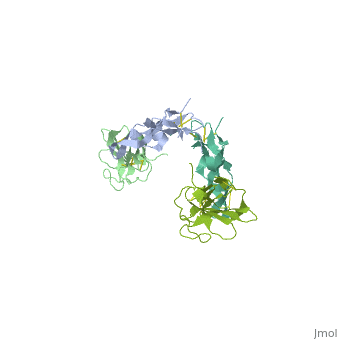TGF-beta receptor
From Proteopedia
(Difference between revisions)
| Line 1: | Line 1: | ||
<StructureSection load='1ktz' size='340' side='right' caption='Human hTGFBR-II extracellular domain (green) complex with TGF-β3 (grey) (PDB code [[1ktz]])' scene=''> | <StructureSection load='1ktz' size='340' side='right' caption='Human hTGFBR-II extracellular domain (green) complex with TGF-β3 (grey) (PDB code [[1ktz]])' scene=''> | ||
| + | __TOC__ | ||
== Function == | == Function == | ||
| - | '''TGF-β receptors''' (Transforming Growth Factor) (TGFBR) are serine/threonine kinase receptors. They are involved in paracrine signaling and are found in many types of tissue. TGF-β ligands include bone morphogenetic proteins, growth and initiation factors, anti-Mullerian hormone, activin, nodal TGF-β. | + | '''TGF-β receptors''' (Transforming Growth Factor) (TGFBR) are serine/threonine kinase receptors. They are involved in paracrine signaling and are found in many types of tissue. TGF-β ligands include bone morphogenetic proteins, growth and initiation factors, anti-Mullerian hormone, activin, nodal TGF-β<ref>PMID:21294712</ref>. There are 3 types of TGFBR: <br /> |
*'''TGFBR I''' forms heteromeric complex with TGFBR II when it is bound to TGF-β. The complex transduces the TGF-β signal from the cell surface to the cytoplasm by phosphorylating proteins which regulate the transcription of genes related to cell proliferation. TGFBR I has high affinity for TGF-β1 and low affinity for TGF-β2. <br /> | *'''TGFBR I''' forms heteromeric complex with TGFBR II when it is bound to TGF-β. The complex transduces the TGF-β signal from the cell surface to the cytoplasm by phosphorylating proteins which regulate the transcription of genes related to cell proliferation. TGFBR I has high affinity for TGF-β1 and low affinity for TGF-β2. <br /> | ||
*'''TGFBR II''' is a tumor suppressor transmembrane protein. TGFBR II has high affinity for TGF-β1 and low affinity for TGF-β2. <br /> | *'''TGFBR II''' is a tumor suppressor transmembrane protein. TGFBR II has high affinity for TGF-β1 and low affinity for TGF-β2. <br /> | ||
| Line 8: | Line 9: | ||
== Disease == | == Disease == | ||
| - | Over-expression of TGF causes kidney disease, diabetes and renal disease. Mutations in TGFBR II cause various types of tumors. | + | Over-expression of TGF causes kidney disease, diabetes and renal disease. Mutations in TGFBR II cause various types of tumors<ref>PMID:23884466</ref>. |
== Structural highlights == | == Structural highlights == | ||
| + | TGFBR structure contains a 100-140 residues ligand-binding N-terminal extracellular domain; a transmembrane domain; a 350-400 amino acid cytoplasmic kinase domain; and a C-terminal zona pellucida (ZP) domain of ca 260 residues which has a role in protein polymerization. | ||
</StructureSection> | </StructureSection> | ||
Revision as of 07:48, 11 September 2016
| |||||||||||
3D Structures of TGF-β receptor
Updated on 11-September-2016
References
- ↑ Koudelakova T, Chovancova E, Brezovsky J, Monincova M, Fortova A, Jarkovsky J, Damborsky J. Substrate specificity of haloalkane dehalogenases. Biochem J. 2011 Apr 15;435(2):345-54. doi: 10.1042/BJ20101405. PMID:21294712 doi:http://dx.doi.org/10.1042/BJ20101405
- ↑ Frischmeyer-Guerrerio PA, Guerrerio AL, Oswald G, Chichester K, Myers L, Halushka MK, Oliva-Hemker M, Wood RA, Dietz HC. TGFbeta receptor mutations impose a strong predisposition for human allergic disease. Sci Transl Med. 2013 Jul 24;5(195):195ra94. doi: 10.1126/scitranslmed.3006448. PMID:23884466 doi:http://dx.doi.org/10.1126/scitranslmed.3006448

